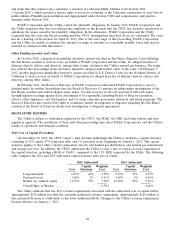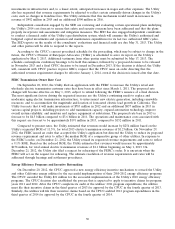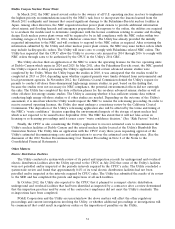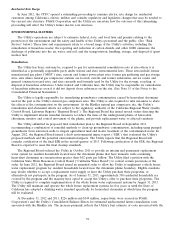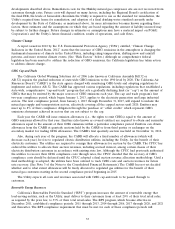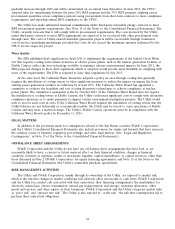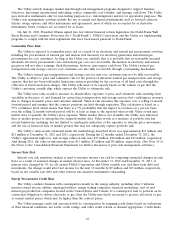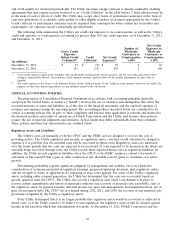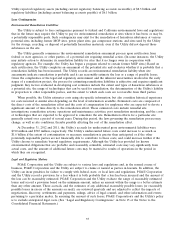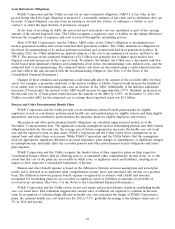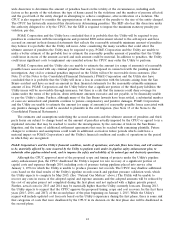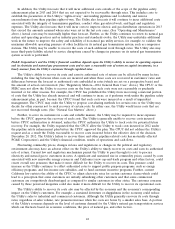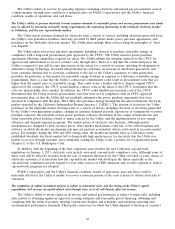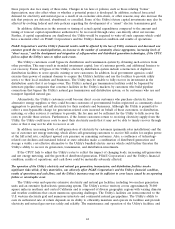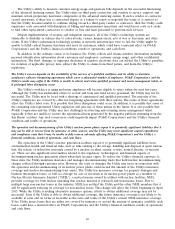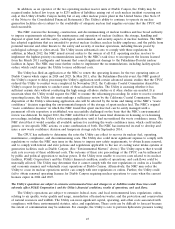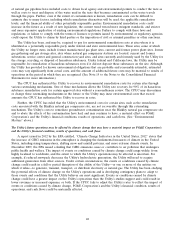PG&E 2012 Annual Report Download - page 42
Download and view the complete annual report
Please find page 42 of the 2012 PG&E annual report below. You can navigate through the pages in the report by either clicking on the pages listed below, or by using the keyword search tool below to find specific information within the annual report.Asset Retirement Obligations
PG&E Corporation and the Utility account for an asset retirement obligation (‘‘ARO’’) at fair value in the
period during which the legal obligation is incurred if a reasonable estimate of fair value and its settlement date can
be made. A legal obligation can arise from an existing or enacted law, statute, or ordinance; a written or oral
contract; or under the legal doctrine of promissory estoppel.
At the time of recording an ARO, the associated asset retirement costs are capitalized as part of the carrying
amount of the related long-lived asset. The Utility recognizes a regulatory asset or liability for the timing differences
between the recognition of expenses and costs recovered through the ratemaking process.
Most of PG&E Corporation’s and the Utility’s AROs relate to the Utility’s obligation to decommission its
nuclear generation facilities and certain fossil fuel-fired generation facilities. The Utility estimates its obligation for
the future decommissioning of its nuclear generation facilities and certain fossil fuel-fired generation facilities. In
December 2012, the Utility submitted an updated estimate of the cost to decommission its nuclear facilities to the
CPUC. The increase in the estimated obligation of $1.3 billion was primarily due to higher spent nuclear fuel
disposal costs and an increase in the scope of work. To estimate the liability, the Utility uses a discounted cash flow
model based upon significant estimates and assumptions about future decommissioning costs, inflation rates, and the
estimated date of decommissioning. The estimated future cash flows are discounted using a credit-adjusted risk-free
rate that reflects the risk associated with the decommissioning obligation. (See Note 2 of the Notes to the
Consolidated Financial Statements.)
Changes in these estimates and assumptions could materially affect the amount of the recorded ARO for these
assets. For example, a premature shutdown of the nuclear facilities at Diablo Canyon would increase the likelihood
of an earlier start to decommissioning and cause an increase in the ARO. Additionally, if the inflation adjustment
increased 25 basis points, the amount of the ARO would increase by approximately 1.57%. Similarly, an increase in
the discount rate by 25 basis points would decrease the amount of the ARO by 4.03%. At December 31, 2012, the
Utility’s recorded ARO for the estimated cost of retiring these long-lived assets was $2.9 billion.
Pension and Other Postretirement Benefit Plans
PG&E Corporation and the Utility provide a non-contributory defined benefit pension plan for eligible
employees as well as contributory postretirement health care and medical plans for eligible retirees and their eligible
dependents, and non-contributory postretirement life insurance plans for eligible employees and retirees.
The pension and other postretirement benefit obligations are calculated using actuarial models as of the
December 31 measurement date. The significant actuarial assumptions used in determining pension and other benefit
obligations include the discount rate, the average rate of future compensation increases, the health care cost trend
rate and the expected return on plan assets. PG&E Corporation and the Utility review these assumptions on an
annual basis and adjust them as necessary. While PG&E Corporation and the Utility believe that the assumptions
used are appropriate, significant differences in actual experience, plan changes or amendments, or significant changes
in assumptions may materially affect the recorded pension and other postretirement benefit obligations and future
plan expenses.
PG&E Corporation and the Utility recognize the funded status of their respective plans on their respective
Consolidated Balance Sheets with an offsetting entry to accumulated other comprehensive income (loss); or, to the
extent that the cost of the plans are recoverable in utility rates, to regulatory assets and liabilities, resulting in no
impact to their respective Consolidated Statements of Income.
Pension and other benefit expense is based on the differences between actuarial assumptions and actual plan
results and is deferred in accumulated other comprehensive income (loss) and amortized into income on a gradual
basis. The differences between pension benefit expense recognized in accordance with GAAP and amounts
recognized for ratemaking purposes are recorded as regulatory assets or liabilities as amounts are probable of
recovery from customers. (See Note 3 of the Notes to the Consolidated Financial Statements.)
PG&E Corporation and the Utility review recent cost trends and projected future trends in establishing health
care cost trend rates. This evaluation suggests that current rates of inflation are expected to continue in the near
term. In recognition of continued high inflation in health care costs and given the design of PG&E Corporation’s
plans, the assumed health care cost trend rate for 2012 is 7.5%, gradually decreasing to the ultimate trend rate of
5% in 2018 and beyond.
38


